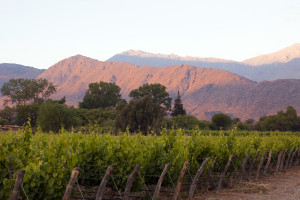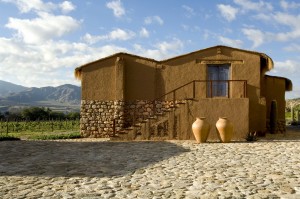Today we have a post from JoAnn DeGaglia, CSW, CS. JoAnn takes us on a trek to some high-altitude vineyards, and even to the legendary land of Shangri-La.
Mountain vineyards have numerous challenges. To get a feel for this, consider the typical challenges faced by all vineyards—such as like power supply, water, and environmental impact, erosion—and multiply them. Then, add in the fact that everyone is working on the side of a steep, difficult (and maybe dangerous) site, and that the complex climate conditions affecting a vineyard site are amplified in the mountains above the fog line. On the brighter side, high elevation sites do receive much more sun with lower heat accumulation and but higher diurnal temperature fluctuations. But then there’s this: pressure from insects, birds, rodents and wild animals is much more intense in remote mountain locations. Like I said—it’s a challenge.
The highest vineyards in the world are in Argentina in the Salta region located in the Altura Maxima vineyard at 9,849 feet (and some claim it is even higher). This “extreme” vineyard produces grapes with a very think skin, resulting in rich, tannic wines with complex flavors. The first vintage of Altura Maxima wine was released in 2012 by Bodega Colomé (part of the Hess Family Estates). That wine—Colomé Altura Maxima 2012—is 100% Malbec and priced at $125. It might sound like a lot—until you realize that only 165 cases (six barrels) were produced. Bodega Colomé also grows small amounts of Torrontés, Pinot Noir, Merlot, Syrah, Sauvignon Blanc and Chardonnay in their ultra-high altitude Altura Maxima vineyard.
Here in the U.S. we look to areas like Lake County AVA (with vineyards at 2,000 to 2,400 feet), Howell Mountain (1,600 to 2,400 feet), Spring Mountain (2,000 feet), Mount Veeder (400 to 2,600 feet), Atlas Peak (1,400 to 2,600 feet), Diamond Mountain (1,200 to 2,200 feet) and Sonoma Mountain (600 to 2,400 feet) as examples of high altitude viticulture. Howell Mountain was designated as Napa Valley’s first sub AVA, and is well-known for its high-altitude Cabernet Sauvignon. The region’s volcanic ash–red clay soil, delightfully infertile, produces intense wines from small berries. In the end, the altitude and rocky, dry soil conditions create complex, tannic and concentrated wines with firm structure, incredible varietal intensity, and excellent aging properties. Cabernet Sauvignon is King of the Mountain but Cabernet Franc, Merlot, Zinfandel and Chardonnay excel as well. Who is up on Howell Mountain? Charles Krug, Cade, Cakebread, Duckhorn, Robert Foley, La Jota, and Pine Ridge—to name a few.
The world of wine evolves and changes with each passing year with more regions discovering wine, both as consumers and producers. Each of these new areas brings a new dimension to the world of wine. One in particular caught the eye of Karen MacNeil, author of The Wine Bible enough to make her declare that “the Book of Cabernet has just been rewritten.” The wine she is talking about is made in Shangri-La. Really. The wine is 2013 Ao Yun (Tibetan for Proud Cloud), produced in the Himalayas just 50 miles from the border of Burma. This area is within the Yunnan Province in the far southwest of China. The areas “Three Parallel Rivers” region (now a National Park) was made famous as the mythical Shangri-La in James Hilton’s novel Lost Horizon. The Vineyard is at 8,500 feet, and the air is so thin that fermentation doesn’t quite work like it does as we may know it. Karen MacNeil described the wine like this: “Drinking it makes you feel like you’ve been pulled down into the dark body of the earth itself. There is a sense of delicious corruption to the wine.”
Ao Youn is 90% Cabernet Sauvignon and 10% Cab Franc, bottled at 15% alcohol by volume. It should be (or will soon be) available at Sherry Lehman’s in New York and Wally’s in Los Angeles.
We can never overestimate the contributions made by the pioneers, innovators and artists of the wine making world. So get out there and open that mountain wine—climb high, my friends.
JoAnn DeGaglia, CSW, CS works at Brotherhood Winery, “America’s Oldest Winery.” In addition, she teaches wine appreciation classes at libraries all over the Hudson Valley as well as with Ned Towle at the Westchester Wine School. JoAnn’s writings may be found on Facebook on the “The Wine Lovers Journey through the World of Wine” page.
Are you interested in being a guest blogger or a guest SWEbinar presenter for SWE? Click here for more information!


A terrific article. Really informative. Great blog